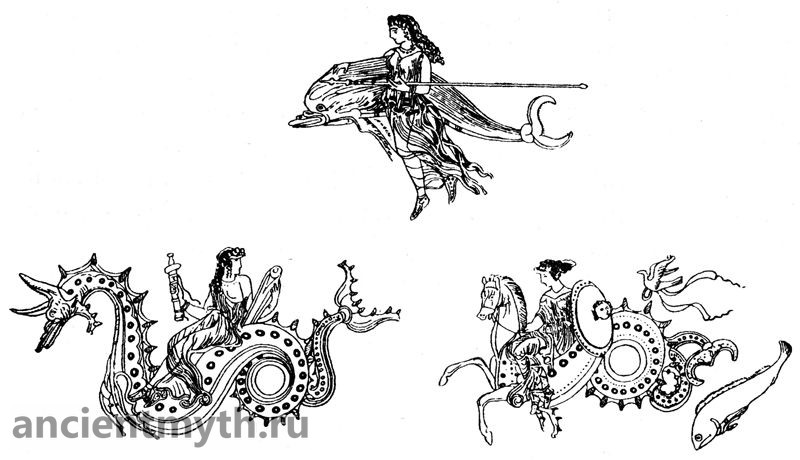Thetis at Hephaestus. Achilles weapon.
The goddess Thetis quickly took off to the bright Olympus to the copper palace of the god Hephaestus. When Thetis came to the palace of Hephaestus, he was in the forge. Covered in sweat, he forged twenty tripods at once. They were on golden wheels, the tripods themselves rolled to the gods and themselves returned back. God only had to attach patterned handles to these tripods. God was forging nails for pens when the goddess Thetis quietly entered the palace. The beautiful wife of the god Hephaestus, Kharita, saw the goddess. She tenderly took Thetis by the hand and said to her:
- Enter into their chamber, Thetis, rarely do you visit us. What need brought you to us?
Harita called Hephaestus, so that he would soon go to the goddess Thetis. Hearing that the goddess Thetis came to him, the one who once saved his life when she threw him from Olympus Hera, Hephaestus hurried to the call of his wife. He rose from the anvil, collected all the tools with which he worked, and put them into a silver-bound casket. Hephaestus wiped his hands, chest, neck and face with a damp sponge, washing off sweat and soot, dressed and, leaning on a thick staff, went out to the goddess Thetis. Under the arms of the god Hephaestus, the servants forged by him from gold, who were as if alive, were led. Hephaestus took Thetis by the hand and asked her:
- Tell me, goddess, what do you need? And if I can, then I'm ready to do everything for you.
Shedding tears, Thetis told how her son lost the armor that the gods gave as a gift to his father Peleus, how she killed Hector Patroclus how grieving Achilles about his friend and wants to take revenge on his friend's killer, but has no weapons. The goddess asked Hephaestus to forge weapons for her son. After listening to Thetis, Hephaestus immediately agreed to forge such weapons for him that all people would marvel at his extraordinary beauty.

(Design on a vase.)
Hephaestus went back to his forge. He took his furs, put them to the furnace and ordered to fan the fire. Furs breathed on the fire, obedient to the desire of Hephaestus, now evenly, now impetuously, fanning a huge flame in the furnace. Hephaestus threw copper, tin, silver and precious gold into the furnace. Then he put down the anvil and grabbed his huge hammer and tongs in his hand. First of all, Hephaestus forged a shield for Achilles. Hephaestus adorned the shield with marvelous images. On it he presented the earth, the sea and the sky, and in the sky - the sun, the moon and the stars. Among the stars he depicted the Pleiades, Hyades, the constellations of Orion and Ursa. On the shield depicted Hephaestus and two cities. Weddings are celebrated in one city. Wedding processions and choirs of young men move along the streets, and women look at them from the thresholds of their homes. And the people's assembly gathered in the square. It features two citizens arguing about vir for murder. Citizens, divided into two parties, support the disputants. Heralds reassure citizens. City elders sit around, and each, taking a scepter in his hand, pronounces his decision on a controversial case. In the circle are two talents of gold as a reward to the one who judges the litigants more fairly. Another city was besieged by enemies. The besieged, leaving wives, youths and elders to defend the city, set up an ambush. They are led by the god Ares and the goddess Athena-Pallas, majestic and formidable. Two scouts are placed in front to watch the enemies. But then the herds captured by the enemies appeared. Citizens hiding in ambush beat off cows and sheep. The enemy heard the noise in the camp and rushed to help. A bloody battle began, and in the battle between the warriors, the goddesses of malice and confusion and the formidable god of death roam. Depicted Hephaestus on a shield and arable land. The plowmen follow the plows. When they reach the edge of the field, goblets of wine are served to them by servants. God also depicted harvesting bread. Some reapers reap bread, others knit it, and children gather ears. The owner of the field is happy to see how a rich harvest is harvested. Off to the side, women prepare dinner for the reapers. Next to it was the grape harvest. Young men and maidens carry grapes in baskets. A beautiful young man plays the lyre, and a cheerful round dance moves around him. Hephaestus also depicted a herd of oxen. Two lions attacked the herd. The shepherds try to drive away the lions, but the dogs are afraid to attack them and only bark. Nearby, silver-fleeced sheep grazing in the valley, stalls, cowsheds and shepherds' huts were depicted. Finally, Hephaestus depicted a round dance of young men and maidens dancing, holding hands, and villagers admiring the dance. Around the entire shield, Hephaestus Ocean, flowing around the earth. Having doneshield, Hephaestus forged the armor of Achilles, burning like a bright flame, a heavy helmet with a golden crest and leggings made of flexible tin.
Having finished the work, Hephaestus took his weapons and took them to the goddess Thetis. Like a fast hawk, she rushed from Olympus to a distant land in order to quickly bring armor to her son.